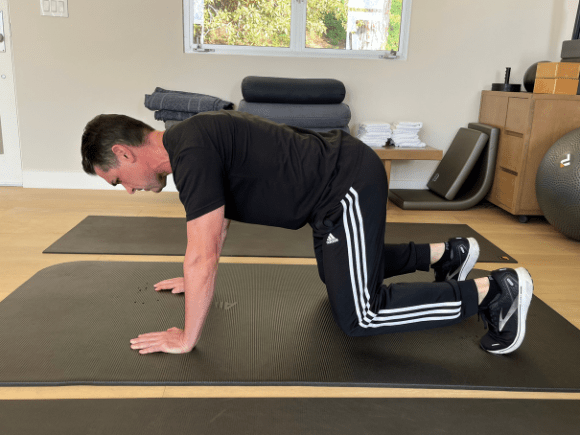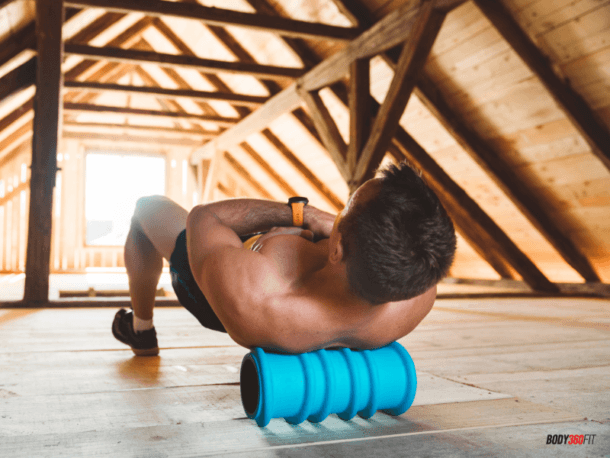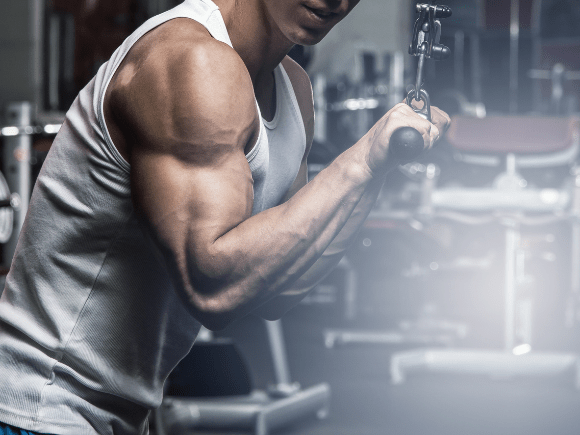Estimated reading time: 9 minutes
Barbell Front Squat Alternatives
Let’s face it, only some people love the barbell front squat. Finding barbell front squat alternatives is a common quest, whether it’s shoulder mobility limitations, a personal preference for a different movement, or simply a desire for other knee-dominant exercises.
Understanding these alternatives provides versatility to your workout routine and effectively targets different muscle groups. This guide will teach you to replace barbell squats with other options to craft a lower-body routine that fits your needs and goals.
Let’s look into knee-dominant exercises and explore the best alternatives to the barbell front squat.
Table of contents
- Barbell Front Squat Alternatives
- Key Takeaways:
- What are Knee Dominant Exercises?
- Why Replace the Barbell Front Squat?
- What are the Benefits of Knee Dominant Exercises?
- 15 Best Front Squat Alternatives and Squat Variations
- 1. DB Goblet Squat
- 2. KB Goblet Squat
- 3. Front Rack Position Dumbbell Squats
- 4. Rack Position KB Squat
- 5. Offset KB Squat
- 6. Split Squat Hold
- 7. 1 DB Suitcase Split Squat
- 8. 2 DB Split Squat
- 9. Goblet Split Squat
- 10. Rear Foot Elevated Goblet Split Squat (Bulgarian Split Squats)
- 11. Keiser Front Squat
- 12. Single-Leg Squat to Bench
- 13. Dumbbell Step-ups
- 14. Goblet Reverse Lunge
- 15. Goblet Slide Board Reverse Lunge
- Sample Knee-Dominant Workout with Chest and Core
- Conclusion:
Key Takeaways:
- You can effectively replace the barbell front squat with various knee-dominant exercises that target similar muscle groups.
- Knee-dominant exercises offer benefits like improved strength, core stability, mobility, and athletic performance.
- Explore the 15 alternatives listed, each with benefits and technique tips.
- Design a personalized workout incorporating knee-dominant exercises alongside chest and core work for well-rounded fitness.
What are Knee Dominant Exercises?
Knee-dominant exercises primarily target the quadriceps, hamstrings, and glutes while emphasizing the knee joint. These exercises enhance lower body strength, stability, and overall functional movement. By isolating and engaging these muscle groups, knee-dominant exercises contribute to improved athletic performance and everyday activities.
Why Replace the Barbell Front Squat?
The versatility of knee-dominant exercises lies in their ability to effectively target the same muscle groups as the barbell front squat while providing variations in movement patterns and equipment usage. Lunges, step-ups, goblet squats, rear foot elevated split squats, landmine squats, the Zercher squat, and single-leg squats are all viable alternatives that offer similar benefits to the traditional front squat. You can achieve balanced lower body development and functional strength by including these leg exercises in your routine.
What are the Benefits of Knee Dominant Exercises?
Knee-dominant exercises offer a multitude of benefits, including:
- Improved Lower Body Strength: By targeting the quadriceps, hamstrings, and glutes, knee-dominant exercises contribute to overall lower body strength development.
- Muscle Growth: Consistent incorporation of knee-dominant exercises into your workout routine can stimulate muscle hypertrophy, increasing muscle mass and definition.
- Reduced Risk of Injury/Less Strain: Strengthening the muscles surrounding the knee joint through knee-dominant exercises can improve joint stability and reduce injury during physical activities.
- Functional Movement Patterns: Many knee-dominant exercises mimic everyday movements, promoting better functional movement patterns, stronger core muscles, and enhancing mobility and agility.
15 Best Front Squat Alternatives and Squat Variations
1. DB Goblet Squat
The DB Goblet Squat is a beginner-friendly alternative to the barbell front squat that targets the quadriceps, glutes, and hamstrings.
- Muscles Worked: Quadriceps, Glutes, Hamstrings.
- Equipment Needed: Dumbbell.
- Things to Avoid: Avoid rounding the lower back and ensure proper alignment of the knees over the toes.
How to Perform:
- Hold a dumbbell vertically against your chest.
- Begin the movement by bending your knees and lowering your hips towards the floor.
- Return to the starting position.
2. KB Goblet Squat
Similar to the DB Goblet Squat, the KB Goblet Squat utilizes a kettlebell as resistance, targeting the same muscle groups.
- Muscles Worked: Quadriceps, Glutes, Hamstrings.
- Equipment Needed: Kettlebell.
- Things to Avoid: Avoid leaning too far forward or rounding the back.
How to Perform:
- Hold a kettlebell close to your chest.
- Begin the movement by bending your knees and lowering your hips towards the floor.
- Keep your hips back and your chest and back straight.
- Return to the starting position.
Watch this video on YouTube
3. Front Rack Position Dumbbell Squats
The Rack Position DB Squat involves holding dumbbells in a rack position, challenging your core stability while targeting the lower body muscles.
- Muscles Worked: Quadriceps, Glutes, Hamstrings, Core.
- Equipment Needed: Dumbbells.
- Things to Avoid: Avoid arching the lower back excessively.
How to Perform:
- Hold dumbbells in front of your shoulders (shoulder height)with palms facing inward.
- Squat down by bending your knees.
- Return to the starting position.
Watch this video on YouTube
4. Rack Position KB Squat
Similar to the Rack Position DB Squat, this variation utilizes kettlebells for added resistance and core engagement.
- Muscles Worked: Quadriceps, Glutes, Hamstrings, Core.
- Equipment Needed: Kettlebells.
- Things to Avoid: Avoid allowing the knees to collapse inward.
How to Perform:
- Hold kettlebells at shoulder height with palms facing inward.
- Squat down by bending your knees.
- Return to the starting position.
Watch this video on YouTube
5. Offset KB Squat
The Offset KB Squat adds an asymmetrical challenge by holding one kettlebell in a racked position, requiring more excellent core stability.
- Muscles Worked: Quadriceps, Glutes, Hamstrings, Core.
- Equipment Needed: Kettlebell.
- Things to Avoid: Avoid excessive leaning to one side.
How to Perform:
- Hold one kettlebell in a racked position on one side.
- Squat down by bending your knees.
- Return to the starting position.
Watch this video on YouTube
6. Split Squat Hold
The Split Squat Hold is an isometric that works the quadriceps, glutes, and hip flexors while improving balance and stability.
- Muscles Worked: Quadriceps, Glutes, Hip Flexors.
- Equipment Needed: None (Bodyweight).
- Things to Avoid: Avoid leaning too far forward or backward.
How to Perform:
- Begin in a split stance position.
- Lower your body until both knees are bent at 90-degree angles.
- Hold the position.
- Return to standing.
Watch this video on YouTube
7. 1 DB Suitcase Split Squat
The 1 Dumbbell Suitcase Split Squat adds a unilateral component by holding a weight in one hand, challenging core stability and balance.
- Muscles Worked: Quadriceps, Glutes, Hamstrings, Core.
- Equipment Needed: Dumbbell or Kettlebell.
- Things to Avoid: Avoid excessive twisting or leaning.
How to Perform:
- Hold a weight in one hand at your side.
- Assume a split stance.
- Lower your body until both knees are bent at 90-degree angles.
- Return to standing.
Watch this video on YouTube
8. 2 DB Split Squat
Utilizing two dumbbells, the 2 DB Split Squat provides balanced resistance to each side of the body, targeting lower body muscles and improving stability.
- Muscles Worked: Quadriceps, Glutes, Hamstrings.
- Equipment Needed: Dumbbells.
- Things to Avoid: Avoid letting the front knee extend beyond the toes.
How to Perform:
- Hold a dumbbell in each hand.
- Assume a split stance.
- Lower your body until both knees are bent at 90-degree angles.
- Return to standing.
Watch this video on YouTube
9. Goblet Split Squat
Similar to the goblet squat, the Goblet Split Squat targets the lower body muscles while improving balance and stability.
- Muscles Worked: Quadriceps, Glutes, Hamstrings.
- Equipment Needed: Dumbbell or Kettlebell.
- Things to Avoid: Avoid letting the front knee cave inward.
How to Perform:
- Hold a weight at chest level.
- Assume a split stance.
- Lower your body until both knees are bent at 90-degree angles.
- Return to standing.
Watch this video on YouTube
10. Rear Foot Elevated Goblet Split Squat (Bulgarian Split Squats)
Elevating the rear foot in the Goblet Split Squat increases the range of motion and challenges stability, targeting the quadriceps, glutes, and hamstrings.
- Muscles Worked: Quadriceps, Glutes, Hamstrings.
- Equipment Needed: Bench or Step, Dumbbell or Kettlebell.
- Things to Avoid: Avoid too much distance between the elevated back foot and the front leg.
How to Perform:
- Elevate the rear foot on a step or bench.
- Hold a weight at chest level.
- Assume a split stance.
- Lower your body until both knees are bent at 90-degree angles.
- Return to standing.
Watch this video on YouTube
11. Keiser Front Squat
The Keiser Front Squat utilizes pneumatic resistance, providing a smooth and controlled movement to target lower body muscles effectively.
- Muscles Worked: Quadriceps, Glutes, Hamstrings.
- Equipment Needed: Keiser Machine.
- Things to Avoid: Avoid locking out the knees at the top of the movement.
How to Perform:
- Adjust the resistance on the Keiser Machine.
- Grasp the handles.
- Squat down by bending your knees.
- Return to the starting position.
Watch this video on YouTube
12. Single-Leg Squat to Bench
The Single Leg Squat is a unilateral exercise that improves balance and stability and targets the quadriceps, glutes, and hamstrings.
- Muscles Worked: Quadriceps, Glutes, Hamstrings.
- Equipment Needed: Bench, light dumbbells for counterbalance.
- Things to Avoid: Avoid leaning too far forward. On the contrary, avoid maintaining an upright position/upright posture.
How to Perform:
- Stand on one leg before a bench with the other extended in front.
- While holding light dumbbells, extend and elevate your arms to chest height.
- Begin the bodyweight squat down by bending the knee of the standing leg, then return to standing.
Coach’s Tip
Add Airex pads to increase seat height. As you progress and get stronger remove pads to increase the level of difficulty.
Watch this video on YouTube
13. Dumbbell Step-ups
Step-ups target the quadriceps, glutes, and hamstrings while improving single-leg strength and stability.
- Muscles Worked: Quadriceps, Glutes, Hamstrings.
- Equipment Needed: Box or Step.
- Things to Avoid: Avoid pushing off the back foot excessively.
How to Perform:
- Hold a set of dumbbells in each hand.
- Step onto a box or step with one foot
- drive through the heel,
- then back down and repeat on the other side.
Watch this video on YouTube
14. Goblet Reverse Lunge
The Goblet Reverse Lunge targets the quadriceps, glutes, and hamstrings while improving balance.
- Muscles Worked: Quadriceps, Glutes, Hamstrings.
- Equipment Needed: Dumbbell or Kettlebell.
- Things to Avoid: Avoid letting the front knee extend beyond the toes.
How to Perform:
- Hold a weight at chest level.
- Step back into a lunge position, lowering the back knee towards the ground.
- Return to standing.
Watch this video on YouTube
15. Goblet Slide Board Reverse Lunge
Utilizing a slide board (adds a dynamic component to the Reverse Lunge, targeting lower body muscles and improving stability.
- Muscles Worked: Quadriceps, Glutes, Hamstrings.
- Equipment Needed: Slideboard, Dumbbell, or Kettlebell.
- Things to Avoid: Avoid letting the front knee collapse inward.
How to Perform:
- Hold a weight at chest level.
- Place one foot on the slide board and slide it back into a lunge position.
- Return to standing.
Coach’s Tip
Replace a sideboard with Valslides. Valslides are a great way to complete this exercise if a slide board is unavailable.
Watch this video on YouTube
Sample Knee-Dominant Workout with Chest and Core
Warm-up: 5-10 minutes of foam rolling, dynamic stretches, light implementation of power, and core activation.
Strength Training Block:
- Goblet Split Squat: 3 sets of 8-12 reps per leg
- Dumbbell Bench Press: 3 sets of 8-12 reps
- Bulgarian Split Squat: 3 sets of 8-12 reps per leg
- Dumbbell Row: 3 sets of 8-12 reps
- Single-Leg Romanian Deadlift: 3 sets of 8-12 reps per leg
Core Strength Block:
- Plank: 3 sets of 30-60 seconds hold
- Anti-rotation Press: 3 sets of 10-15 reps per side
Cool-down: 5-10 minutes of foam rolling static stretches.
Coach’s Tip: Adapt the exercises, sets, reps, and weight to your fitness level and goals. Consult a trainer or healthcare professional for personalized guidance.
Conclusion:
Incorporating barbell front squat alternatives into your workout routine offers a diverse range of exercises to effectively target the same muscle groups. Whether you want to improve lower body strength, enhance muscle growth, or reduce the risk of injury, knee-dominant exercises provide a versatile and functional approach to strength training. By exploring various squat alternatives, you can customize your training program to suit your goals and preferences while experiencing similar benefits to the traditional front squat.
Feel free to mix and match exercises from this list to create unique and challenging workouts focusing on different muscle groups and compound movement patterns. Keep things fun and progressive; you’ll be amazed at your accomplishments.
Remember, safety and proper form are paramount in any exercise regimen. Start with lighter weights before progressing to heavier loads. With dedication and consistency, knee-dominant exercises can become valuable to your overall strength training routine.
Until next time,
Christian Graham—NSCA-CPT, CFSC2, FMS2, KB, VIPR
Functional Strength & Mobility Specialist – @Body360Fit
PS. And remember, you’re just one workout away…
PPS. Did you enjoy reading this article about barbell front squat alternatives? If so, please share it with your friends on Twitter, Facebook and Pinterest.
If you have have any questions regarding how to properly train your legs or how to assemble the proper training program, please ask in the comments below. You can also send me a message via the contact form. I’d love to hear from you!
Additional Learning
- Ditch the Barbell: 15 Killer Barbell Front Squat Alternatives (with Videos!)
- 7 Unilateral Back Exercises You NEED to Be Doing (For Symmetry & Strength)
- Vega vs. Orgain Protein Powder: A Head-to-Head Comparison
- Indulge Your Cravings: Healthy Cookies and Cream Protein Powder Recipe
- Tribulus Terretris Spotlight: Unveiling the Top 11 Tribulus Supplements with Expert Insights


















![Full Body Kettlebell Workout [PDF] | Body360 Fit](https://body360fit.com/wp-content/uploads/2021/01/Full-Body-Kettlebell-Workout-PDF.png)







